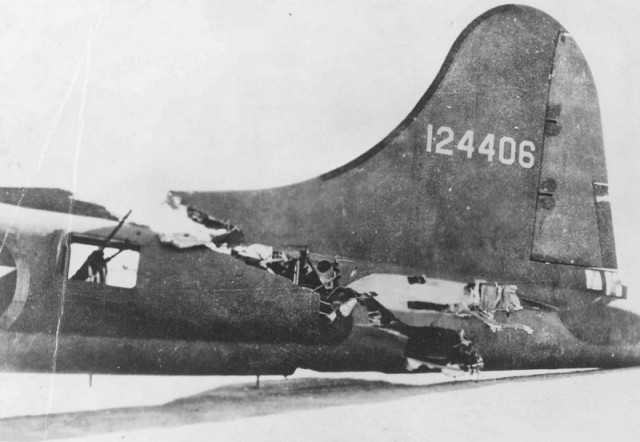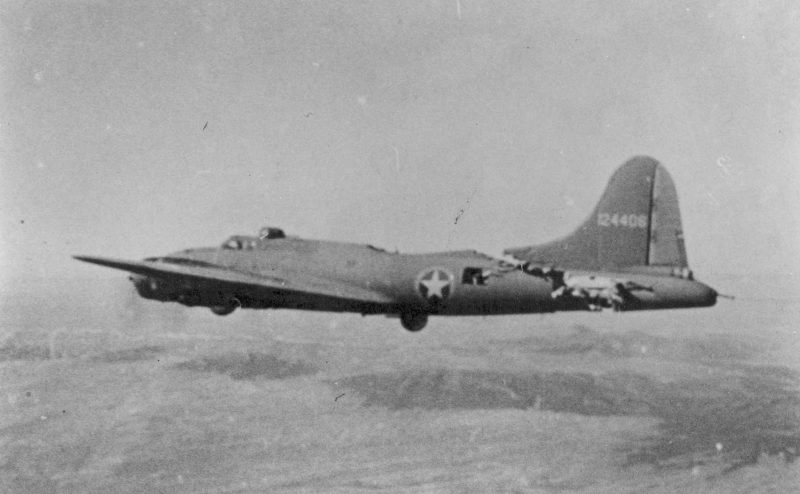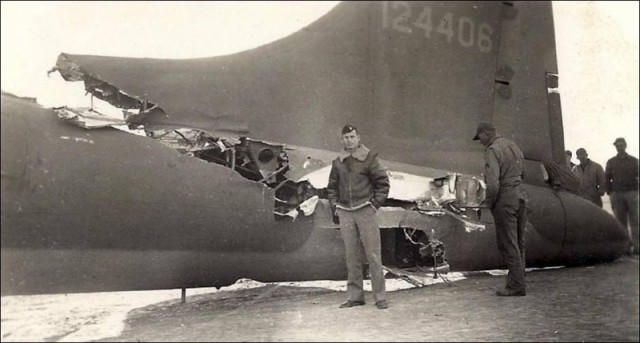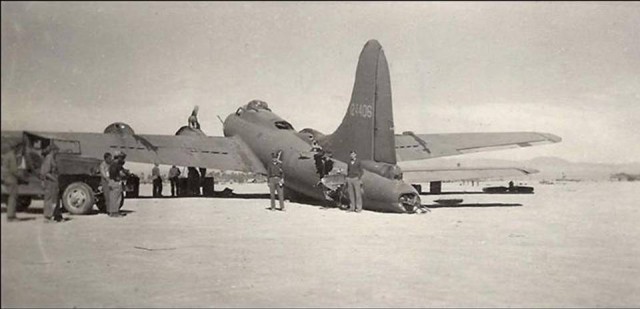On February 1, 1943, there was a collision in mid-air between a B-17 bomber and a German fighter plane over the Tunis dock area in Tunisia, North Africa. The pictures of the damaged bomber became some of the most legendary photographs of World War II.
It begins when an enemy fighter, attacking the formation of the 97th Bomber Group, that presumably had an injured pilot, was spinning out of control and crashed into the back of the fuselage of a B-17 Flying Fortress bomber that was called ‘All American.’ The B-17 was piloted by Lt. Kendrick R. Bragg, of the 414th Bomb Squadron. The German fighter craft broke apart when it hit the Fortress, but left some pieces in the bomber.
The left elevator and the left horizontal stabilizer of the B-17 were entirely ripped off. The radios, the oxygen system, and the electrical system were all severely damaged. The vertical stabilizer and the rudder had been ravaged. The fuselage had been split almost totally through; attached with only two small parts of the frame and the cut in the main body went all the way to the top gunners firing position.
Both of the starboard engines were out, and one engine on the port side had a severe leak in the oil pump, and there was also a hole in the top of the bomber that was over 4 feet wide at its widest point and 16 feet long.
The tail section actually wobbled and bounced during flight and twisted when the plane turned. All the control cables were detached, except one single elevator cable that still worked. Miraculously – the Flying Fortress still flew!
There was no floor linking the tail section to the rest of the plane, consequently the bomber’s tail gunner was trapped. The midsection gunners and the tail section gunners used some of the parts of the German fighter that were lodged in the B-17 and their own parachute shackles trying to keep the tail from tearing off and trying to hold together the two sides of the fuselage.
As the crew worked feverishly to keep the bomber from ripping apart, the pilot continued toward his target and successfully released his bombs.
When the pilot opened the bomb bay doors, the instability of the B-17 and the wind turbulence was so great that it propelled one of the midsection gunners into the broken tail section. It took four crew members several minutes to pass him cord from the parachutes and haul him back into the front part of the plane.
They thought about doing the same for the tail gunner, but they didn’t account for the gunner providing stable weight for the tail section, so he went back as the tail was starting to break off.

After the completion of the bombing run, the train back home to England had to be very slow and meticulous so the tail wouldn’t rip off. The turn for home in the ravaged B-17 actually covered almost 70 miles.
The Flying Fortress was so seriously damaged that the altitude was slowly dropping, it was losing speed, and was soon flying alone in the sky. On the way home the B-17 had a brief encounter with two more ME-109 Luftwaffe fighters.
The machine gunners were able to repel these assaults despite the widespread damage and quickly drove the fighters off. The two midsection gunners had to stand with their heads protruding through the hole in the top of the main section of the bomber to shoot their machine guns.
The tail gunner was in a strange predicament; as he was shooting the recoil from the gun was causing the plane to turn so he decided that he could fire in short bursts.
P-51 fighters taking flight from England caught up with the ‘All American’ Flying Fortress as it crossed the English Channel and took one of the pictures that became instantly famous. They contacted base headquarters recounting that the tail assembly was waving like a fish tail and that the plane wouldn’t make it to land.
The pilots suggested that boats be sent to rescue the crew when they bailed out. Lt. Bragg was relaying messages to the P-51 pilots with hand signals as they flew alongside the B-17 and the pilots, in turn, passed the messages on to base command.
Lt. Bragg communicated that all of the parachutes had been utilized to make repairs to sections of the plane, so the crew was unable to bail out. He told the pilots that since they couldn’t bail out; he would stay with the bomber and land it.
The Flying Fortress made its final turn to the runway two and a half hours after being nearly destroyed, while it was still over 40 miles away. It plummeted into an emergency situation and a wheels-up belly landing.
The ambulance was waved off when it pulled alongside because not one member of the crew had been hurt. It was unbelievable that the B-17 was still able to fly in such a state of disrepair.
The Fortress sat sedately on the runway until each crew member got off the plane through the hole in the fuselage and the tail gunner had descended a ladder, at which time the complete rear section of the aircraft crumpled to the ground. The rugged old bird had completed its mission.
B-17 “All American” (414th Squadron, 97BG) Crew
Pilot- Ken Bragg Jr.
Copilot- G. Boyd Jr.
Navigator- Harry C. Nuessle
Bombardier- Ralph Burbridge
Engineer- Joe C. James
Radio Operator- Paul A. Galloway
Ball Turret Gunner- Elton Conda
Waist Gunner- Michael Zuk
Tail Gunner- Sam T. Sarpolus
Ground Crew Chief- Hank Hyland
Video
From the diary of Lt. Col. Kermit D. Wooldridge, 525th Bomb Squadron, 379th Bomb Group, 8th Air Force. The fine line between life and death is described in his own words from a diary entry dated July 17, 1943.
Editors note:
Our friends at Warbirdsnews have researched this story and it seems that not all is correct: http://www.warbirdsnews.com/warbird-articles/wwiis-b-17-all-american-separating-fact-fiction.html


